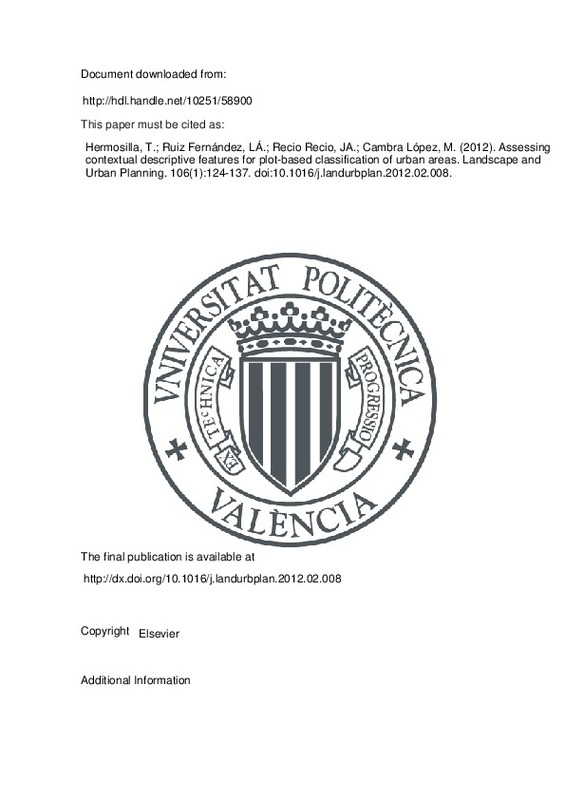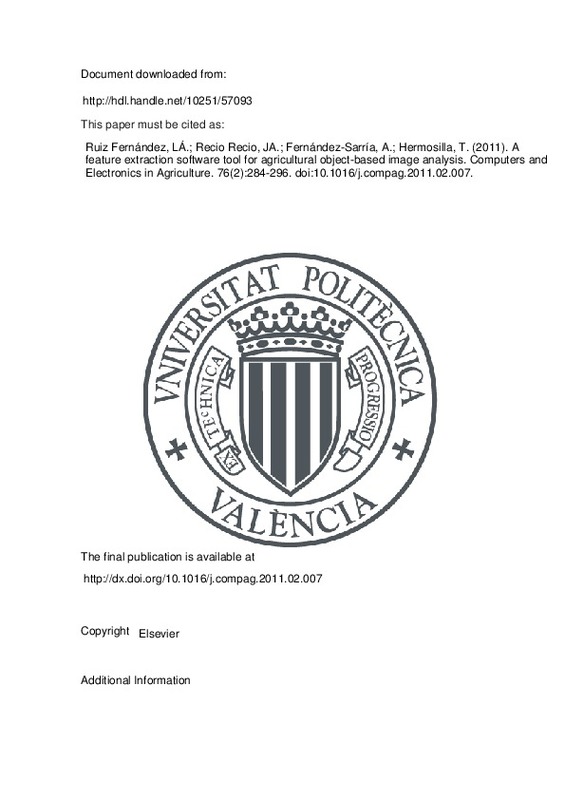JavaScript is disabled for your browser. Some features of this site may not work without it.
Buscar en RiuNet
Listar
Mi cuenta
Estadísticas
Ayuda RiuNet
Admin. UPV
Assessing contextual descriptive features for plot-based classification of urban areas
Mostrar el registro sencillo del ítem
Ficheros en el ítem
| dc.contributor.author | Hermosilla, T.
|
es_ES |
| dc.contributor.author | Ruiz Fernández, Luis Ángel
|
es_ES |
| dc.contributor.author | Recio Recio, Jorge Abel
|
es_ES |
| dc.contributor.author | Cambra López, María
|
es_ES |
| dc.date.accessioned | 2015-12-16T14:17:19Z | |
| dc.date.available | 2015-12-16T14:17:19Z | |
| dc.date.issued | 2012-05-15 | |
| dc.identifier.issn | 0169-2046 | |
| dc.identifier.uri | http://hdl.handle.net/10251/58900 | |
| dc.description.abstract | A methodology for mapping urban land-use types integrating information from multiple data sources (high spatial resolution imagery, LiDAR data, and cadastral plots) is presented. A large set of complementary descriptive features that allow distinguishing different urban structures (historical, urban, residential, and industrial) is extracted and, after a selection process, a plot-based image classification approach applied, facilitating to directly relate the classification results and the urban descriptive parameters computed to the existent land-use/land-cover units in geospatial databases. The descriptive features are extracted by considering different hierarchical scale levels with semantic meaning in urban environments: buildings, plots, and urban blocks. Plots are characterised by means of image-based (spectral and textural), three-dimensional, and geometrical features. In addition, two groups of contextual features are defined: internal and external. Internal contextual features describe the main land cover types inside the plot (buildings and vegetation). External contextual features describe each object in terms of the properties of the urban block to which it belongs. After the evaluation in an heterogeneous Mediterranean urban area, the land-use classification accuracy values obtained show that the complementary descriptive features proposed improve the characterisation of urban typologies. A progressive introduction of the different groups of descriptive features in the classification tests show how the subsequent addition of internal and external contextual features have a positive effect by increasing the final accuracy of the urban classes considered in this study. © 2012 Elsevier B.V. | es_ES |
| dc.description.sponsorship | The authors appreciate the financial support provided by the Spanish Ministry of Science and Innovation and FEDER in the framework of the projects CGL2009-14220 and CGL2010-19591/BTE, and the support of the Spanish Instituto Geografico Nacional (IGN). | en_EN |
| dc.language | Inglés | es_ES |
| dc.publisher | Elsevier | es_ES |
| dc.relation.ispartof | Landscape and Urban Planning | es_ES |
| dc.rights | Reserva de todos los derechos | es_ES |
| dc.subject | Classification | es_ES |
| dc.subject | Contextual features | es_ES |
| dc.subject | High-resolution imagery | es_ES |
| dc.subject | Land-use mapping | es_ES |
| dc.subject | LiDAR | es_ES |
| dc.subject | Urban areas | es_ES |
| dc.subject | Classification approach | es_ES |
| dc.subject | Classification results | es_ES |
| dc.subject | Classification tests | es_ES |
| dc.subject | Contextual feature | es_ES |
| dc.subject | Geo-spatial database | es_ES |
| dc.subject | Geometrical features | es_ES |
| dc.subject | High resolution imagery | es_ES |
| dc.subject | High spatial resolution imagery | es_ES |
| dc.subject | Image-based | es_ES |
| dc.subject | Integrating information | es_ES |
| dc.subject | Land-cover types | es_ES |
| dc.subject | Landuse classifications | es_ES |
| dc.subject | LIDAR data | es_ES |
| dc.subject | Multiple data sources | es_ES |
| dc.subject | Selection process | es_ES |
| dc.subject | Urban environments | es_ES |
| dc.subject | Urban structure | es_ES |
| dc.subject | Feature extraction | es_ES |
| dc.subject | Land use | es_ES |
| dc.subject | Optical radar | es_ES |
| dc.subject | Semantics | es_ES |
| dc.subject | Three dimensional | es_ES |
| dc.subject | Classification (of information) | es_ES |
| dc.subject | Accuracy assessment | es_ES |
| dc.subject | Database | es_ES |
| dc.subject | Hierarchical system | es_ES |
| dc.subject | Image classification | es_ES |
| dc.subject | Land classification | es_ES |
| dc.subject | Mapping method | es_ES |
| dc.subject | Pattern recognition | es_ES |
| dc.subject | Spatial resolution | es_ES |
| dc.subject | Typology | es_ES |
| dc.subject | Urban area | es_ES |
| dc.subject.classification | INGENIERIA CARTOGRAFICA, GEODESIA Y FOTOGRAMETRIA | es_ES |
| dc.subject.classification | BIOLOGIA ANIMAL | es_ES |
| dc.subject.classification | PRODUCCION ANIMAL | es_ES |
| dc.title | Assessing contextual descriptive features for plot-based classification of urban areas | es_ES |
| dc.type | Artículo | es_ES |
| dc.identifier.doi | 10.1016/j.landurbplan.2012.02.008 | |
| dc.relation.projectID | info:eu-repo/grantAgreement/MICINN//CGL2010-19591/ES/DESARROLLO DE METODOLOGIAS INTEGRADAS PARA LA ACTUALIZACION DE BASES DE DATOS DE OCUPACION DEL SUELO/ | es_ES |
| dc.relation.projectID | info:eu-repo/grantAgreement/MICINN//CGL2009-14220-C02-01/ES/CGL2009-14220-C02-01/ | es_ES |
| dc.rights.accessRights | Abierto | es_ES |
| dc.contributor.affiliation | Universitat Politècnica de València. Departamento de Ingeniería Cartográfica Geodesia y Fotogrametría - Departament d'Enginyeria Cartogràfica, Geodèsia i Fotogrametria | es_ES |
| dc.contributor.affiliation | Universitat Politècnica de València. Departamento de Ciencia Animal - Departament de Ciència Animal | es_ES |
| dc.description.bibliographicCitation | Hermosilla, T.; Ruiz Fernández, LÁ.; Recio Recio, JA.; Cambra López, M. (2012). Assessing contextual descriptive features for plot-based classification of urban areas. Landscape and Urban Planning. 106(1):124-137. doi:10.1016/j.landurbplan.2012.02.008 | es_ES |
| dc.description.accrualMethod | S | es_ES |
| dc.relation.publisherversion | http://dx.doi.org/10.1016/j.landurbplan.2012.02.008 | es_ES |
| dc.description.upvformatpinicio | 124 | es_ES |
| dc.description.upvformatpfin | 137 | es_ES |
| dc.type.version | info:eu-repo/semantics/publishedVersion | es_ES |
| dc.description.volume | 106 | es_ES |
| dc.description.issue | 1 | es_ES |
| dc.relation.senia | 222339 | es_ES |
| dc.contributor.funder | Ministerio de Ciencia e Innovación | es_ES |
| dc.contributor.funder | Instituto Geográfico Nacional | es_ES |







![[Cerrado]](/themes/UPV/images/candado.png)


